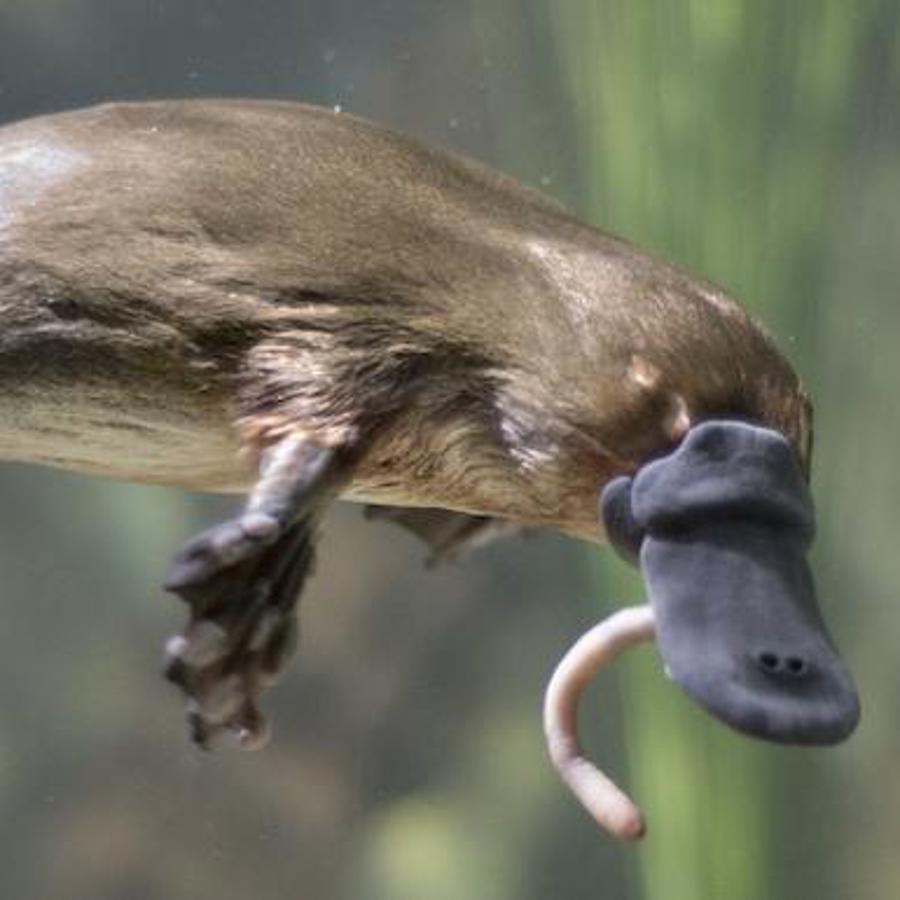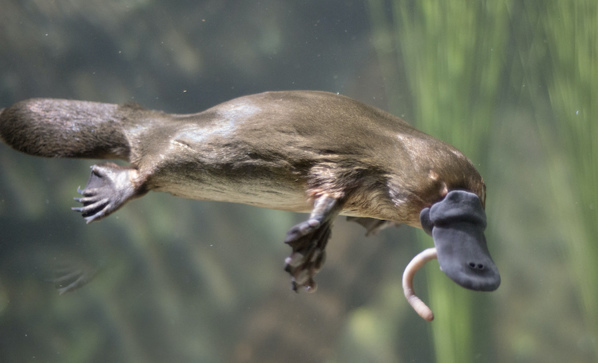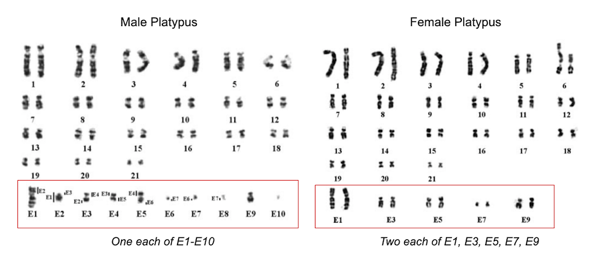
What kind of genes do platypuses have?
June 16, 2006

- Related Topics:
- Chromosomes,
- Genetic sex,
- Animal biology,
- Quirky questions
A curious middle school student from California asks:
"What kind of genes do duck billed platypuses have?"
What a fun question. Platypuses are those weird animals that look like a cross between a duck and a sea otter. And believe it or not, at least some of their genes might be similar to both birds and mammals!
Not too much is known right now about the specific genes that platypuses have. A project similar to the Human Genome Sequencing project is going on right now for the platypus.1
Once that's done, we'll have lots of detailed data that can really get at your question.
In the meantime, we can look at the chromosomes of a platypus. Let's focus on how platypuses become male or female, because it is the weirdest thing I've seen.

How sex chromosomes work
Nearly all mammals determine their sex based on chromosomes. If you have an X and a Y chromosome, you usually end up as a male. Two X chromosomes and you're a female.
How does this work? Well, there is a gene on the Y chromosome called SRY. This gene triggers the development of a male. Without the gene, you are a female.
Scientists know about this because of conditions like Swyer's syndrome. In Swyer's syndrome, the SRY gene doesn't work. People with this syndrome develop as female, despite having an X and Y chromosome.
Sex determination works a little differently in birds. The difference is that the chromosomes are called W and Z (instead of X and Y), and that a W and a Z make a female and two Z chromosomes make a male.
The gene involved in bird sex determination isn't yet known. In other words, the bird version of the SRY gene hasn't been found.
One candidate gene is the DMRT1 gene found on the Z chromosome although this hasn't been confirmed yet. If true, then the DMTR1 gene is pretty different from SRY. Either having only one DMRT1 makes you a female or having two copies makes you a male.
Sex chromosomes in the platypus
OK, so what's that got to do with a platypus? Well, a platypus has ten sex chromosomes instead of just two.2
More precisely, it has five pairs of sex chromosomes. The chromosomes have been named E1-E10.
Females have five paired sex chromsomes (that is, each chromosome is paired with another chromsome of the same type). Specifically, they have two each of E1, E3, E5, E7, and E9.
Males, on the other hand, have ten unpaired chromosomes (that is, all of them are different). They have one each of chromosomes E1-E10.

In other words, males have one copy each of 5 chromosomes that females also have, and 5 copies each of chromosomes that females don’t have.
This makes them similar to mammals with XY chromosomes. If you have the same sex chromosomes in a pair, you are a female (similar to having two X chromosomes). Have two different chromosomes in a pair, and you end up a male.
And yet, there is no hint of an SRY gene. There are a couple of other mammals where SRY hasn't been found yet either so that isn't completely unique. Except one of the chromosomes has something on it that looks like DMRT1 -- the possible bird sex determination gene.
DMTR1 is on E9, one of the chromosomes that if you have two of them, you are a girl platypus. In birds, if you have two chromosomes with DMTR1, then you are a male. So in platypuses, if the DMTR1 gene is involved, it works differently than it does in birds.
But something on all of the other X-like chromosomes might be involved too. Or on all of those Y-like chromosomes.
I think it is safe to say that we don't know yet how it works. One thing we do know is that E1 is pretty similar to other mammalian X chromosomes. And that E9 has DMRT1 and so is sort of like a Z chromosome.
In fact, when you look at cells during meiosis, all 10 of these chromosomes form a chain. At one end is the "mammalian" XY pair and at the other the "bird" WZ pair.
As you can see, the platypus is very different from mammals and birds. I can't wait to hear what they find out next!

Author: Dr. D. Barry Starr
Barry served as The Tech Geneticist from 2002-2018. He founded Ask-a-Geneticist, answered thousands of questions submitted by people from all around the world, and oversaw and edited all articles published during his tenure. AAG is part of the Stanford at The Tech program, which brings Stanford scientists to The Tech to answer questions for this site, as well as to run science activities with visitors at The Tech Interactive in downtown San Jose.
 Skip Navigation
Skip Navigation
